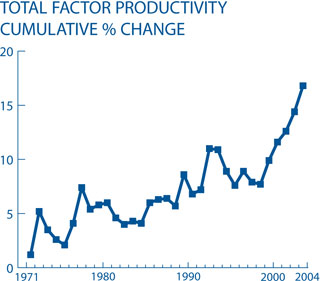 |
page 25 of 55 |  |
|
We deliver more than 312 million pieces of mail every day, handling 46% of the world's mail volume. Japan is second, with 6%. |
financial review Part II |
|
H.R. 3798 and H.R. 4312. Both bills would have required that cargo transported on passenger planes be screened or inspected using the same equipment, technology and personnel that are used to screen passenger baggage. H.R. 3798 would have also required "shippers" to pay fees to passenger airlines to cover the costs of additional screening. Our preliminary analysis suggests that we would be considered a shipper and would have to pay such fees if similar legislation is enacted in the future. Productivity We use two indicators to measure our efficiency. We use output per workhour which measures the change in the relationship between workload (mail volume and deliveries) and the labor resources used to do the work. We use total factor productivity (TFP) to measure the change in the relationship between outputs, or workload, and all the resources used in producing these outputs. Our main output is delivered mail and special services and carrier service to an expanding delivery network. TFP calculations include inputs for all resources including labor, materials, transportation and capital investments. During 2004, our output per workhour grew by 2.4% and our TFP improved by 2.4%. This TFP growth is equivalent to $1.6 billion in expense reductions. This marks our fifth consecutive year of TFP growth, with equivalent expense reductions totaling over $6.1 billion over this time. By comparison, in 2003 our output per workhour was 2.3% and our TFP was 1.8%. Our productivity growth continues to be driven by substantial restraints on the resources we use to produce our outputs. We were able to achieve TFP growth with only a small increase in workload, in contrast to the years before 2001 when our TFP growth was fueled largely by managing an ever-increasing workload. We have instituted measures to ensure continued TFP growth. It is now our policy to develop an annual budget so that the net income target also yields positive and sustainable TFP growth.
|
Capital Investments The Board of Governors approves the budget for investments in capital property and equipment each year. The Board also approves all major capital projects, generally defined as projects greater than $10 million. At the beginning of the year, there were 49 Board-approved projects in progress, representing $6,609 million. During the year, the Board approved 21 new projects for $1,816 million and 21 projects were completed, representing $2,685 million. While the funding for a project is authorized in one year, the commitment, or contract to purchase or build, may occur over several years. Similarly, actual payment for the project, or capital cash outlays, may take place over several years. The $1,685 million in capital outlays for 2004 represents outlays for commitments made in previous years as well as commitments made in 2004 for all 49 projects. Of the 49 active Board-approved projects at the close of the year, 24 were for mail processing equipment, 12 for facilities, and 13 for other projects such as retail equipment, vehicles and information infrastructure support. Our total capital commitment plan for 2005 is $3.3 billion, with cash outlays planned at $2.0 billion, of which approximately $1.2 billion is for commitments made in prior years and the remaining $800 million for new commitments in 2005. Future Our capital plan for the future calls for developing and deploying new automation and mechanization equipment that will increase our operating efficiency. We will continue to maintain our infrastructure, including facilities, vehicles, and systems, as well as making return on investment projects. We will make investments in programs that reduce workhours in our distribution, processing and delivery operations. We have set our capital commitment plan at a level higher than 2004 to invest in programs that reduce workhours in our distribution, processing and delivery operations, such as Phase II of the Postal Automated Redirection System and the Optical Character Reader Enhancements for Letter Automation program. As we continue to focus on customer and employee safety, the Biohazard Detection System will be attached to the Advanced Facer-Canceller System and flats cancellers to detect potential Biohazards. Our facilities program will continue to address life, health, safety, and security issues. Our facility plan has increased as we invest in those facilities in our delivery system that we have placed on a priority list. With an annual average growth of approximately 1.8 million delivery points every year, we will maintain our infrastructure through high priority replacement projects and ongoing repair and alteration projects. |
